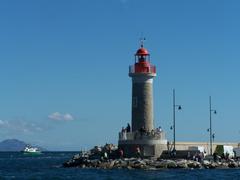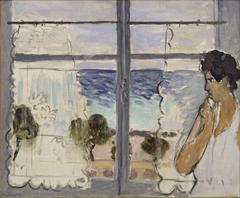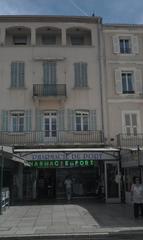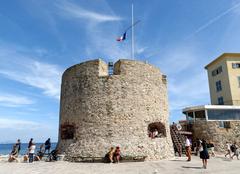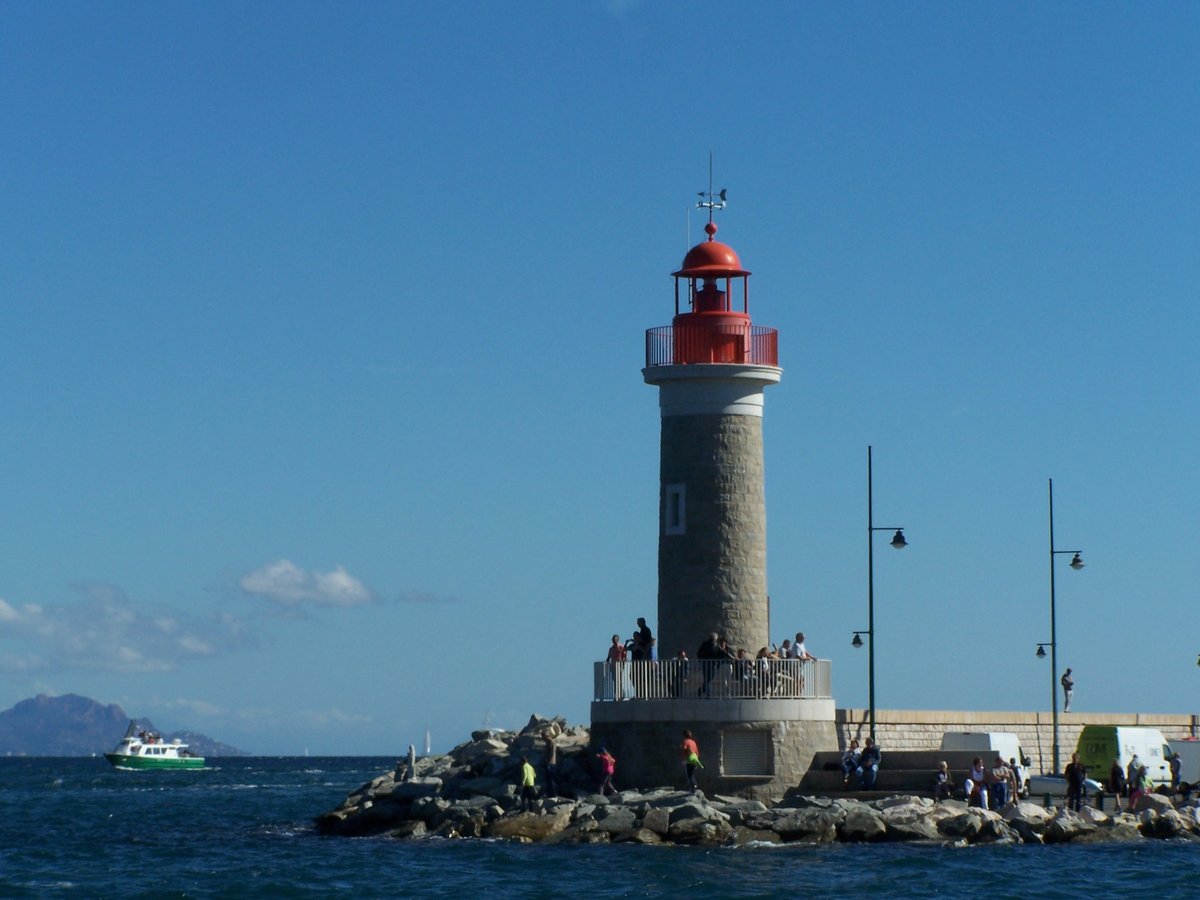
Visiting Phare de Saint-Tropez: Hours, Tickets, and Travel Tips
Date: 01/08/2024
Introduction
Saint-Tropez, a dazzling gem on the French Riviera, is renowned for its rich history, cultural vibrancy, and luxurious lifestyle. From its origins as the ancient town of Athenopolis, founded by the Phocaeans in 599 BC, to its current status as a global hotspot for celebrities and tourists, Saint-Tropez has a storied past that continues to captivate visitors (Wikipedia). This guide aims to provide comprehensive insights into one of the town’s most iconic landmarks—the Phare de Saint-Tropez, or Saint-Tropez Lighthouse. This lighthouse, with its rich maritime history dating back to 1858, has been a beacon of safety for sailors navigating the Mediterranean Sea and a symbol of the town’s enduring allure (Wikipedia). Whether you’re planning to explore its historical significance, enjoy nearby attractions, or simply take in its picturesque setting, this guide will equip you with all the necessary information, from visiting hours and ticket details to travel tips and recommended activities.
Table of Contents
History of Saint-Tropez
Early History
Saint-Tropez, known in ancient times as Athenopolis, was established by the Phocaeans from Ionia in 599 BC when they founded Massilia (modern-day Marseille) and other coastal mooring sites in the area (Wikipedia). The region was later invaded by the Romans in 31 BC, who built opulent villas, including the “Villa des Platanes” (Wikipedia). The Gulf of Saint-Tropez was known as sinus Sambracitanus, a name that likely survives in the settlement name of Les Issambres (Wikipedia).
The Legend of Saint Torpes
The town owes its name to Saint Torpes, an early Christian martyr. According to legend, Torpes was a Roman soldier who served Emperor Nero. After refusing to renounce his Christianity, he was decapitated, and his body was set adrift in a boat with a rooster and a dog. The boat eventually landed at the present-day location of Saint-Tropez (SeeSaintTropez).
Medieval Period
After the fall of the Roman Empire, Saint-Tropez faced a century of attacks and sackings by pirates and privateers. From 890 to 972, the area became an Arab-Muslim colony dominated by the Saracenic settlement of Fraxinet (Wikipedia). In 976, William I, Count of Provence, began attacking the Muslims and built a tower where the Suffren tower now stands (Wikipedia).
Renaissance and Rebirth
In the 15th century, Count René I of Provence sought to repopulate the area. He created the Barony of Grimaud and invited the Genoan Raphael de Garezzio to bring 60 Genoese families to the region. These families were granted various privileges, including tax exemptions and the right to bear arms. On February 14, 1470, they landed in Saint-Tropez and began rebuilding the town (Wikipedia). By 1479, the new Home Act was signed, marking the rebirth of Saint-Tropez (FranceTravelBlog).
17th to 19th Century
In September 1615, Saint-Tropez was visited by a delegation led by the Japanese samurai Hasekura Tsunenaga, marking the first contact between the French and the Japanese (Wikipedia). The local noblemen raised an army that repulsed a fleet of Spanish galleons on June 15, 1637, an event commemorated by the local celebration Les Bravades des Espagnols (Wikipedia).
20th Century and Beyond
Saint-Tropez remained a military stronghold and fishing village until the early 20th century. It was the first town on its coast to be liberated during World War II as part of Operation Dragoon on August 15, 1944 (SeeSaintTropez). After the war, the town gained international fame, particularly in the 1960s, when the film “And God Created Woman” starring Brigitte Bardot was released. This film catapulted both Bardot and Saint-Tropez into the international spotlight, making the town a hotspot for the European and American jet set (SeeSaintTropez).
Modern Day
Today, Saint-Tropez is renowned for its luxurious lifestyle, beautiful beaches, and vibrant cultural scene. It continues to attract celebrities and tourists from around the world, maintaining its status as a premier destination on the French Riviera (Wikipedia).
Phare de Saint-Tropez
Historical Significance
The Phare de Saint-Tropez, or Saint-Tropez Lighthouse, has a rich history dating back to 1858 when a fixed red light was first mounted on a cast-iron candelabrum (Wikipedia). The first lighthouse, known as the “phare rouge,” was built in 1866 at the end of the large jetty. It was a 15-meter-high cylindrical masonry tower with a more powerful fixed red light. In 1932, the lighthouse was electrified and became a red light with three occultations every fifteen seconds (Wikipedia).
Destruction and Reconstruction
The original lighthouse was destroyed in 1944 by German troops during World War II. From 1952 to 1968, it was replaced by a reinforced concrete tower, which was eventually demolished in 2000. A temporary wooden pylon with a light was used for 32 years until the construction of a new “phare rouge” began in 1999. The new lighthouse, identical to the original, was inaugurated and put into service on January 1, 2001 (Wikipedia).
Visitor Information
Best Time to Visit
The best time to visit Saint-Tropez is during the late spring and early fall when the weather is pleasant, and the crowds are smaller. The summer months can be very busy, with tourists flocking to the beaches and the town’s many attractions.
Getting There
Saint-Tropez is accessible by car, boat, and public transportation. The nearest major airports are in Nice and Marseille, both of which are about 100 kilometers away. From there, visitors can take a train, bus, or rent a car to reach Saint-Tropez.
Attractions
- La Citadelle and Musée d’Histoire Maritime: This 17th-century citadel offers stunning views of the town and houses a maritime museum with a rich collection of artifacts (Travel2Next).
- Eglise Notre Dame De l’Assomption: A brightly colored Italian baroque-style church built in 1784, home to statues and wood carvings dating back to the early 19th century (Travel2Next).
- Musée de l’Annonciade: An art museum housed in a former 16th-century chapel, showcasing works by contemporary artists who have worked in the town (Travel2Next).
Activities
- Beach Visits: Saint-Tropez boasts some of the most beautiful beaches in the world, including Plage de la Moutte, a quieter, unspoiled beach perfect for swimming and snorkeling (Travel2Next).
- Yacht Watching: The Vieux Port de Pêche and Port De Saint-Tropez offer a blend of history and luxury, with weathered fishing boats docked among expensive yachts (Travel2Next).
- Wine Tasting: Visitors can enjoy wine tasting and vineyard tours, sampling a range of wines accompanied by French cheeses and local delicacies (Travel2Next).
Dining
Saint-Tropez offers a wide range of dining options, from casual beachside cafes to upscale restaurants. Visitors can enjoy traditional French cuisine, fresh seafood, and international dishes.
Accommodation
There are numerous accommodation options in Saint-Tropez, ranging from luxury hotels to charming bed and breakfasts. It is advisable to book in advance, especially during the peak tourist season.
Nearby Attractions
Explore the surrounding areas of Saint-Tropez, such as the picturesque village of Ramatuelle, the vibrant city of Cannes, and the historic town of Grimaud.
Special Events
Saint-Tropez hosts a variety of events throughout the year, including the famous Les Voiles de Saint-Tropez regatta, the Saint-Tropez Polo Club tournaments, and the annual Bravades festival.
Guided Tours
Various guided tours are available, offering unique insights into the history, culture, and natural beauty of Saint-Tropez. Options include walking tours, boat tours, and wine tours.
Photographic Spots
Capture the beauty of Saint-Tropez at iconic spots such as the Vieux Port, the Citadelle, and the scenic beaches. Don’t miss the stunning sunset views from the top of the citadel.
FAQ
What are the visiting hours for Saint-Tropez attractions?
Visiting hours vary by attraction, with most sites open from 10 AM to 6 PM. It’s advisable to check individual attraction websites for specific hours.
How to get tickets for Saint-Tropez events?
Tickets for events can be purchased online through official event websites or at local tourist offices. Early booking is recommended, especially for popular events.
Conclusion
By exploring the rich history and vibrant culture of Saint-Tropez, visitors can enjoy a memorable experience in this iconic French Riviera destination. Don’t forget to download our mobile app Audiala for more travel tips and updates.
